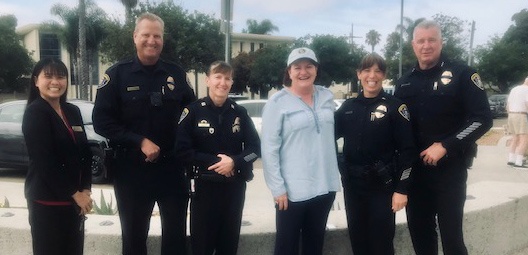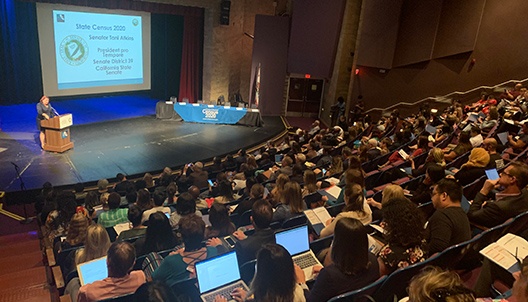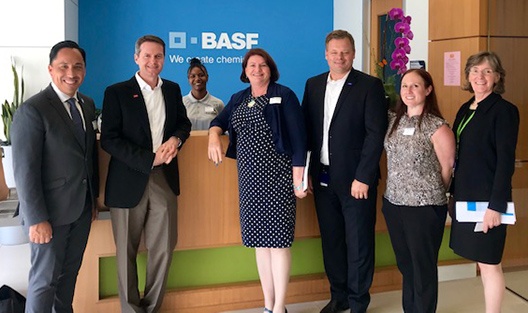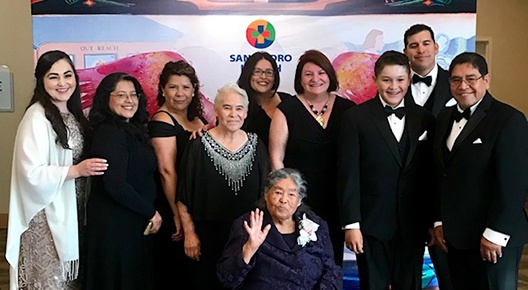September 2019 Newsletter
 |
Three young lives were cut short on July 28 in Gilroy, California – a 6-year-old boy, Stephen Romero; a 13-year-old girl, Keyla Salazar; and a 25-year-old man, Trevor Irby. They were indiscriminately murdered while attending a community celebration, the Gilroy Garlic Festival, where people should be concerned with nothing more than great food, lively music, and enjoying one another’s company.
We had barely gotten to know who they were before a horrific massacre occurred in El Paso just six days later, when a racist gunman traveled 650 miles to “kill Mexicans” at a popular Walmart. Before he was apprehended, he murdered 22 people with the same kind of military-style weapon used in Gilroy.
We had little time to catch our breath before we heard the news that just 12 hours later, another young man had randomly killed nine people at a bar in Dayton, Ohio, also using a military-style weapon.
I didn’t need to personally know Stephen, Keyla, or Trevor to feel deep sadness. I need only think about people of similar ages who I do know, and how their young lives are full of promise, hope, and infinite possibilities. I didn’t need to know any of the 31 people who died needlessly in El Paso and Dayton. I need only think about their families and friends, and the indescribable pain of loss they must feel.
We must not succumb to numbness as these incidents mount. We must continue to do whatever we can to keep ourselves, our families, and our communities safe.
California has been trying to do just that. Our state leads the nation in sensible gun regulation.
We’ve restricted who can legally sell firearms, and how they can sell them. We’ve required a waiting period between sale of a firearm and possession, barred anyone younger than 21 from purchasing a gun, and limited purchases to one gun per month. We’ve banned those who are prone to violence from buying firearms. We’ve restricted sales of ammunition in various ways. We’ve strengthened our laws on where and how guns can be carried. And we’ve banned certain high-powered weapons that have no place in the hands of anyone who is not in the military and fighting on a battlefield. Additional gun-control measures are currently under consideration in the Legislature.
Data show a strong correlation between stricter gun laws and fewer gun-related deaths, according to CalMatters, citing research by the Centers for Disease Control and Prevention. There’s no doubt in my mind that these laws have made Californians safer.
However, despite our efforts, we cannot claim success. Mass shootings are still happening.
What is certain is that California cannot go it alone.
The Gilroy murders are evidence of that. I won’t name the shooter, and I don’t want to say much about him, but I will point out that the weapon he used – similar to an AK-47 – is banned in California. He was able to get his hands on it and use it to kill three Californians and injure 15 others because it was perfectly legal for him to buy it in Nevada. Transporting the weapon across state lines was likely illegal, but no one wants to see cars being searched before they’re allowed to enter California.
Nearly 40% of guns used in crimes that could be traced to a source come from a state other than the one where the crime was committed, according to Vox, citing federal government data – and Arizona and Nevada lead the nation in providing weapons for out-of-state crimes.
As long as our neighbors continue to treat weapon sales with such a laissez-faire attitude, and as long as the federal government allows such a wildly varied patchwork of gun laws, Californians – and all Americans – will be less safe from mass shootings.
The Second Amendment is a stalking horse for those who profit from the sale of weapons. I grew up in the South, and I understand that hunting and gun ownership are a part of everyday life in some communities. But hunting rifles and handguns used to protect one’s family aren’t going to be confiscated. No civilian needs to possess military-style weaponry. And there’s no good reason to oppose thorough background checks.
Congress and the White House should have immediately tightened federal gun laws after 20 first- and second-graders were slaughtered at Sandy Hook Elementary School in 2012, if not long before that.
Heartbreakingly, it’s too late for those children. It’s too late for the 34 innocent people who died in Gilroy, El Paso, and Dayton – not to mention our own backyard of Poway, where Lori Gilbert-Kaye was murdered on April 27 at her synagogue. But it’s not too late for those who might die in the next shooting. Or the next. Or the next.
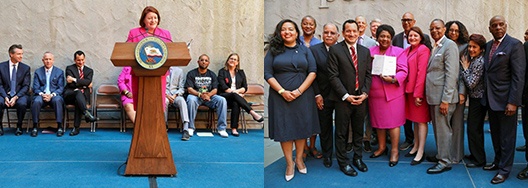 I was proud to participate alongside colleagues when Governor Gavin Newsom signed AB 392, and grateful for the leadership of Assemblymember Dr. Shirley Weber (center, right photo). |
Monday, August 18, was a landmark day in California. That’s when Governor Gavin Newsom signed AB 392 and placed our state firmly on the right side of history, and I was proud to be there to witness it firsthand.
AB 392 reforms the standard for when law-enforcement officers may use lethal force. For the past 147 years, officers have been permitted to use lethal force when they believed that doing so was “reasonable.” Going forward, officers may do so when it is “necessary.”
I believe AB 392 will reduce preventable deaths without jeopardizing police-officer safety. This much-needed revision to our law is proof that real change can happen. It’s the result of long, hard work by my colleagues in the Legislature, victims’ families, civil-rights leaders, and law-enforcement officials.
And it would not have happened if not for the tenacity of San Diego Assemblymember Dr. Shirley Weber, the bill’s author. Throughout the process, Dr. Weber approached difficult negotiations with clarity, passion, and resolve. I consider it an honor to have helped bring the bill across the finish line.
This law is not a magic fix for the racial tensions that are endemic in our country, but it does send a clear message that California is taking action to improve the safety of all our communities, especially our communities of color.
And it is testament to California, again, setting a new standard for our nation.
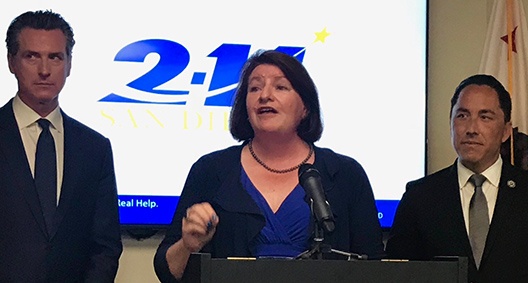 Talking about health care funding with Governor Gavin Newsom and Assemblymember Todd Gloria at 2-1-1 San Diego. |
I was pleased to join Governor Gavin Newsom in San Diego on August 9 to share the great news that California has become the first state in the nation to make health care more affordable for many middle- and lower-income residents.
Thanks to funding included in the state budget that Governor Newsom signed in June, nearly 1 million Californians will benefit from new health care subsidies. This includes:
- An estimated 235,000 middle-income Californians who previously did not qualify for financial help because they exceeded federal income requirements. The assistance they receive will help them save an average of 23% on their insurance premiums.
- An estimated 663,000 Covered California enrollees who currently receive federal financial help. They will save an average of 5% on their current premiums.
- An estimated 23,000 Covered California enrollees whose annual household income falls below 138% of the federal poverty level. They’ll see their premiums lowered to $1 per member, per month.
As a result, Covered California’s next rate increase will be historically low – less than 1% statewide and even lower in San Diego!
After decades of careening from budget crisis to budget crisis, we have turned our state finances around during the past nine years and have made necessary new investments to shore up our battered safety-net programs. But the damage to the middle class has often been overlooked.
Not this year. As the leader of the Senate Democrats, I’m proud to say that we are making strengthening the middle class a top priority.
While the federal government and other states are sabotaging people’s access to health care, California is investing in quality, affordable care.
And we want more and more eligible residents to sign up for Covered California – to strengthen the overall program and improve health outcomes for our families. Open enrollment starts October 15 and runs through January 15.
 |
Until September 20, San Diego County businesses, nonprofit groups and government agencies can apply for funding to swap out polluting heavy-duty trucks, machinery, and equipment for electric and low-carbon-emission alternatives – through the San Diego County Air Pollution Control District’s Clean Air for All Grant Campaign.
A total of $28.5 million is available for this program. The funding comes from the California Air Resources Board’s Carl Moyer Program, named for the later Dr. Carl Moyer, a key figure in developing California’s air-quality standards.
The program is one of many ways California is leading in the battle against climate change and the effort to rid our communities of air pollution.
Click here for grant applications and information.
This year’s legislative session ends on September 13, our deadline for sending this year’s bills to the Governor for his signature. As of late-August, each of my bills, listed below, was in the Assembly Appropriations Committee awaiting release to the Assembly floor.
SB 1 – the California Environmental, Public Health, and Workers Defense Act of 2019 – is California’s “insurance policy” against the reckless deregulation happening at the federal level. SB 1 ensures that any federal environmental or worker safety standard in place as of January 19, 2017, remains in effect under state law even if the federal government rolls it back.
SB 66 allows clinics and rural health care providers to bill Medi-Cal for two visits on the same day if patients receive mental health treatment on the same day they receive other medical treatment. This will help ensure health care providers can continue to deliver vital mental health services and be reimbursed for those services.
SB 165 is the next step to ensure that limited English proficient Medi-Cal enrollees have qualified in-person language interpreter services when they visit their medical provider. The bill is a follow-up to AB 635, which required a study of the issues surrounding medical interpreters and creates a four-site pilot project.
SB 451 creates an economic-development tool by establishing a tax credit for the preservation and rehabilitation of historic buildings in California. To qualify, the property must be on the National Register of Historic Places or the California Register of Historical Resources. The applicable credit will be for 20% of the qualified rehabilitation expenditures, and would offer a 5% bonus on top of that if certain criteria are met. California is one of 15 states that do not have a state-level historic preservation tax credit.
SB 507 transfers the remaining submerged areas within San Diego Bay controlled by the State Lands Commission to the Port of San Diego. The bay’s waters would be better managed by the same local agency that oversees the land around the bay – the Port of San Diego. SB 507 is common-sense and overdue legislation that will improve environmental, economic and safety conditions in San Diego Bay and eliminate duplicative efforts while maintaining the protection of the public tidelands.
|
Social Media Corner |
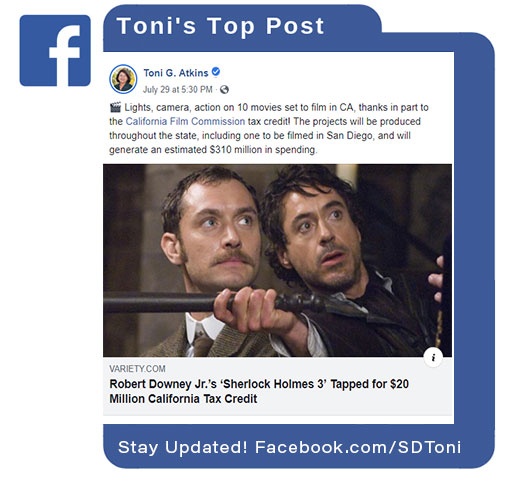 |
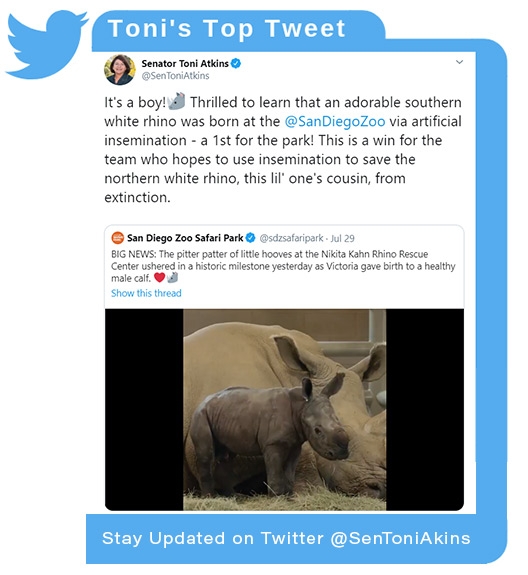 |
My district staff is always available to help constituents navigate a complex web of state agencies. If you’re having trouble working out an issue with any state agency, please call my office at 619-645-3133, and my staff will do everything in their power to help.
|
My District Staff |
Where to Find Me Online
|
My district office is located at 1350 Front St., Room 4061, San Diego, CA 92101.
|
|
|
|
|
|
|
|
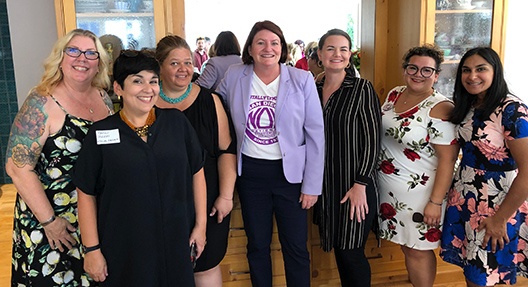 I want to thank San Diego NOW for inviting me to their PhenomeNOW event honoring women who paved the way. I am who I am today because of two women: my mom, Betty Atkins, and my mentor, Christine Kehoe. I stand on their shoulders. |
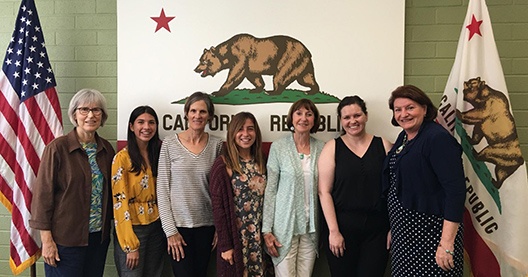 I had an insightful meeting with members of San Diego 350 about climate action and other issues. I’m grateful to have such passionate advocates to work with in my district. |

